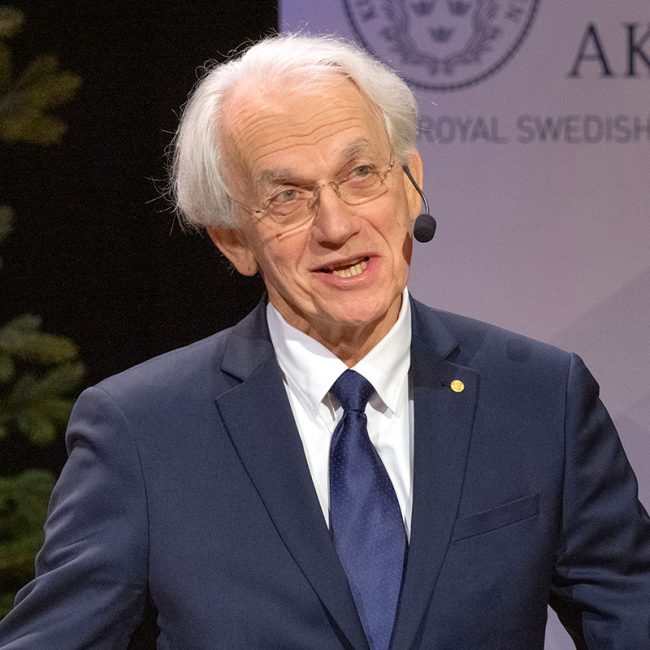Vilnius (BNS)
The French scientist Gerard Mourou, the winner of the Nobel Prize in Physics in 2018, says that the main reason of success of the Lithuanian laser industry is the researchers. In his opinion, the pioneer of laser physics in Lithuania, Algis Piskarskas, is worth the Nobel Prize.
This week, G. Mourou visited companies ‘Light Conversion’ and ‘Ekspla’ based in Vilnius that have already built a global reputation. Furthermore, on Tuesday, he was declared as the foreign member of the Lithuanian Academy of Sciences.
G. Mourou gave interview to the BNS.
– What was the purpose of your visit to Lithuania?
– The main reason of me being here is my inauguration as the foreign member of the Lithuanian Academy of Sciences. It is a great honour for me.
– Why, in your opinion, is Lithuania so successful in the field of laser industry?
– One of the reasons is that you have very goods scientists, good people. Professor Piskarskas is one of them. He is an excellent teacher – with his cooperation many of his students managed to develop these companies. which are now the best in the world. I also think that you have a very good combination – a company (‘Light Conversion’ – BNS) and the Laser Research Centre of the Vilnius University nearby, which I haven’t seen yet, but I already know about. It is very convenient. Here you have a good infrastructure.
– What made the biggest impression when visiting companies ‘Light Conversion’ and ‘Ekspla’?
– I was impressed by the variety – there are scientific lasers, but you also have lasers designed for the industry. I saw a lot of lasers and it is excellent in creating business and jobs – high value-adding jobs. In my opinion, it is particularly important. They (employees – BNS) are not making burgers, they are doing high-level jobs.
– You received the Nobel Prize for the invention of chirped pulse amplification technology. How could you explain the core of this technology?
– We tried to develop an ultra-high maximum power. Not necessarily very high average power. Power is a work divided by time – if you want to obtain an ultra-high maximum power, you need to have ultra-short light impulses. When we say short impulses, we mean millionths, billionths of a second. With impulses to short even the lowest amount of energy allows us to generate a petawatt of power. The petawatt peak power is so enormous that we can compare it with the total power generated by all the nuclear power plants around the world.
– Is that an ultra-powerful laser?
– Yes, it is a powerful laser, but it cannot be of a length of one or two metres, because a meter needs more energy. We use a very moderate amount of energy, however, the maximum power is enormous.
– What are the areas of application of this technology in practice?
– It is mostly applied in the fields of science, but can also have many applications for the needs of the society, for example, in laser vision correction surgeries. We basically have an ideal scalpel – with impulses so short we can cut the eye tissue with extreme precision. We can also accelerate the particles, accelerate the electrons. It is mostly applied in physics, but can also be applied in medicine, for example, in treating cancer.
– The winners of Nobel Prizes, especially in physics, usually come from large countries. Are there any chances for the scientists of small countries, such as Lithuania, to win the Nobel Prize in physics?
– In think you have a chance. The problem is that it is difficult to forecast. Considerable efforts are put in the process of selection of the winner. For example, I can tell you that Professor Piskarskas is certainly worth the Nobel Prize. People like him are worth it.
– However, it seems like there is more amiability to the bigger countries when selecting the winners of the Nobel Prize, isn’t it?
– No, I don’t think so. Of course, more winners of the Nobel Prize come from the United States, but that is because they have many universities with many faculties. It is the main reason why many winners of the Nobel Prize are from the big countries, but I don’t think that there is a certain amiability.
– Thank you for the interview.
—————–
G. Mourou received the Nobel Prize for the invented chirped pulse amplification (CPA) technology last year together with the Canadian researcher Donna Strickland.
The researcher has been cooperating with the Laser Research Centre of the Vilnius University and professor A. Piskarskas since 1992. The CPA modification – optic parametric chirped-pulse amplification (OPCPA) technology – was invented in Lithuania in 1992.
CPA technology is applied in lasers produced by ‘Light Conversion’ which are used by the largest global biochemistry, physics, chemistry and industry centres in Germany, Japan, the USA, China and the Great Britain.

